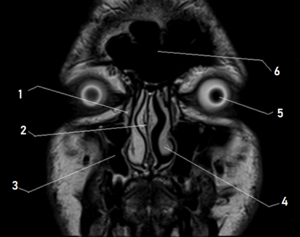2495514
Muscular System
Description
No tags specified
Flashcards by RadTech Fairy, updated more than 1 year ago
More
Less

|
Created by RadTech Fairy
over 9 years ago
|
|
Resource summary
| Question | Answer |
| Gross Anatomy of Skeletal Muscle 1. blood vessel 2. fascicle 3. Epimysium 4. Myofibril 5. Perimysium 6. Endomysium 7. tendon 8. bone | |
| Sarcomere of a Myofibril A. Z-Line B. H-zone C. I Band D. A Band E. M Line | |
| Neuromuscular Junction 1. nerve 2. sarcolemma 3. synaptic vessel containing ACh 4. acetylcholine (ACh) receptor 5. mitochondrion | |
| Elements of Fibers and Myofibrils A. T-tubule B. Triad C. H-Zone D. Z-Line E. Sarcomere | |
| Sarcomere 1. Sarcomere 2. Myofibril 3. Actin 4. Myosin 5. I Band 6. Z-disc 7. A Band 8. M Line | |
| MASSETER origin: zygomatic arch insertion: mandible function: chewing | |
| ORBICULARIS OCULI origin: maxillary and frontal bones insertion: eyelid tissue function: closing eye, blinking | |
| ORBICULARIS ORIS origin: maxilla and mandible insertion: with muscles and mouth tissues function: closes mouth, purses lips | |
| STERNOCLEIDOMASTOID origin: manubrium, medial portion of clavicle insertion: mastoid process function: flex head, rotate head | |
| TRAPEZIUS origin: occipital bone, spines of C7, T1-12 insertion: acromion process, scapular spine, clavicle function: stabilizes scapula, extends head | |
| INFRASPINATUS origin: posterior surface of scapula insertion: greater tubercle of humerus function: rotates arm laterally | |
| RHOMBOID MAJOR origin: spines of upper thoracic vertebrae insertion: medial border of scapula function: raises and adducts scapula | |
| LATISSIMUS DORSI origin: iliac crest insertion: intertubercular groove of humerus function: extends, adducts arm | |
| PECTORALIS MAJOR origin: clavicle, sternum, 2nd-6th costal cartilages insertion: intertubercular groove function: flexes, extends arm | |
| PECTORALIS MINOR origin: anterior surface 3-5 ribs insertion: coracoid process of scapula function: forward movement of scapula, or draws ribs superiorly | |
| SERRATUS ANTERIOR origin: lateral side of ribs 1-8 insertion: anterior surface of scapula function: rotates scapula, abduction of arm | |
| EXTERNAL INTERCOSTALS origin: inferior border, rib above insertion: superior border, rib below function: forced inhalation, lifts rib cage | |
| INTERNAL INTERCOSTALS origin: superior border below rib insertion: inferior border above rib function: forced exhalation, squeezes ribs together | |
| RECTUS ABDOMINIS origin: symphysis-pubis, crest of pubis insertion: xiphoid process, 5-7 costal cartilages function: flexes vertebral column | |
| EXTERNAL OBLIQUE origin: lower eight ribs insertion: iliac crest function: lateral rotations, tenses abdomen | |
| INTERNAL OBLIQUE origin: iliac crest insertion: lower three ribs function: lateral rotations, tenses abdomen | |
| DELTOID origin: acromium process, spine of scapula, clavicle insertion: deltoid tuberosity function: abducts arm | |
| TRICEPS BRACHII origin: scapula, proximal humerus insertion: olecranon process of ulna function: extends forearm | |
| BICEPS BRACHII origin: scapula, coracoid process above glenoid fossa insertion: radial tuberosity function: flexes forearm, supinates hand | |
| BRACHIORADIALIS origin: lateral supracondyle, humerus insertion: styloid process of radius function: forearm flexion | |
| FLEXOR CARPI ULNARIS origin: olecranon process and medial condyle of humerus insertion: base of 5th metacarpal function: wrist flexor | |
| GLUTEUS MAXIMUS origin: dorsal ilium, sacrum, coccyx insertion: proximal femur function: extends thigh | |
| GLUTEUS MEDIUS origin: ilium insertion: greater trochanter of the femur function: abducts thigh | |
| BICEPS FEMORIS origin: ischial tuberosity, distal femur insertion: head of fibula, lateral condyle of tibia function: extends thigh, flexes knee | |
| SEMITENDONOSUS origin: ischial tuberosity insertion: medial proximal tibia function: extends thigh, flexes knee | |
| SEMIMEMBRANOSUS origin: ischial tuberosity insertion: medial condyle of tibia function: extends thigh, flexes knee | |
| SARTORIUS origin: anterior superior iliac spine insertion: medial proximal tibia function: rotates thigh laterally, flexes, abducts thigh, and flexes knee | |
| GRACILIS origin: body of pubis insertion: medial tibia just below the medial condyle function: adducts thigh, flexes leg | |
| RECTUS FEMORIS origin: anterior inferior iliac spine insertion: patella function: extends knee, flexes thigh | |
| VASTUS LATERALIS origin: greater trochanter insertion: patella function: extends knee, stabilizes knee | |
| VASTUS MEDIALIS origin: greater trochanter insertion: patella function: extends knee | |
| VASTUS INTERMEDIALIS origin: proximal femur anterior insertion: patella function: extends knee | |
| TIBIALIS ANTERIOR origin: lateral condyle fibula insertion: medial cuneiform, 1st metatarsal function: dorsiflexion of foot | |
| GASTROCNEMIUS origin: medial and lateral condyles of femur insertion: posterior calcaneus function: plantar flexes foot | |
| SOLEUS origin: superior tibia, fibula insertion: posterior calcaneus function: plantar flexes foot |
Want to create your own Flashcards for free with GoConqr? Learn more.
